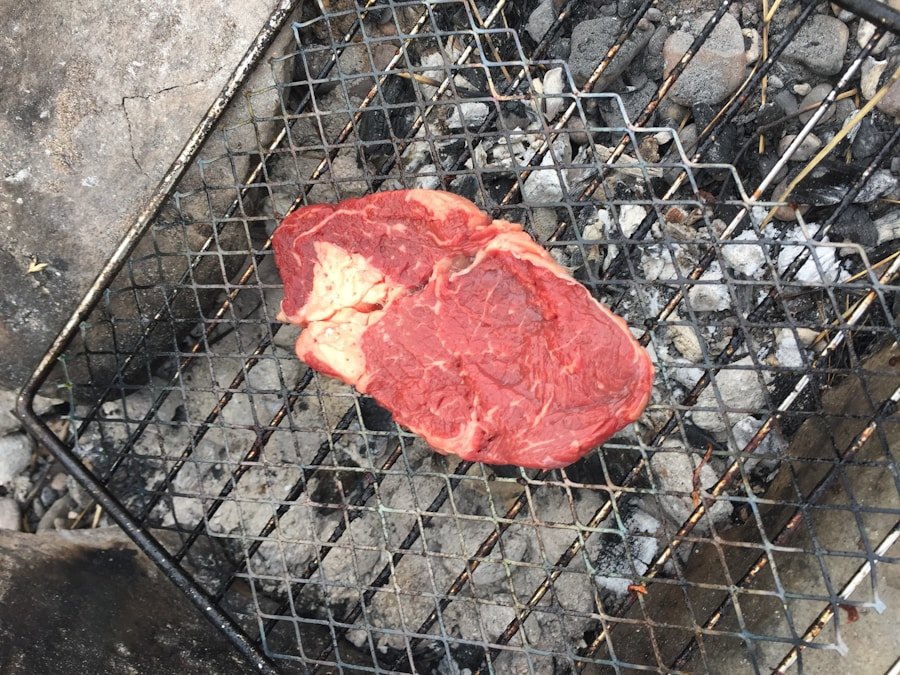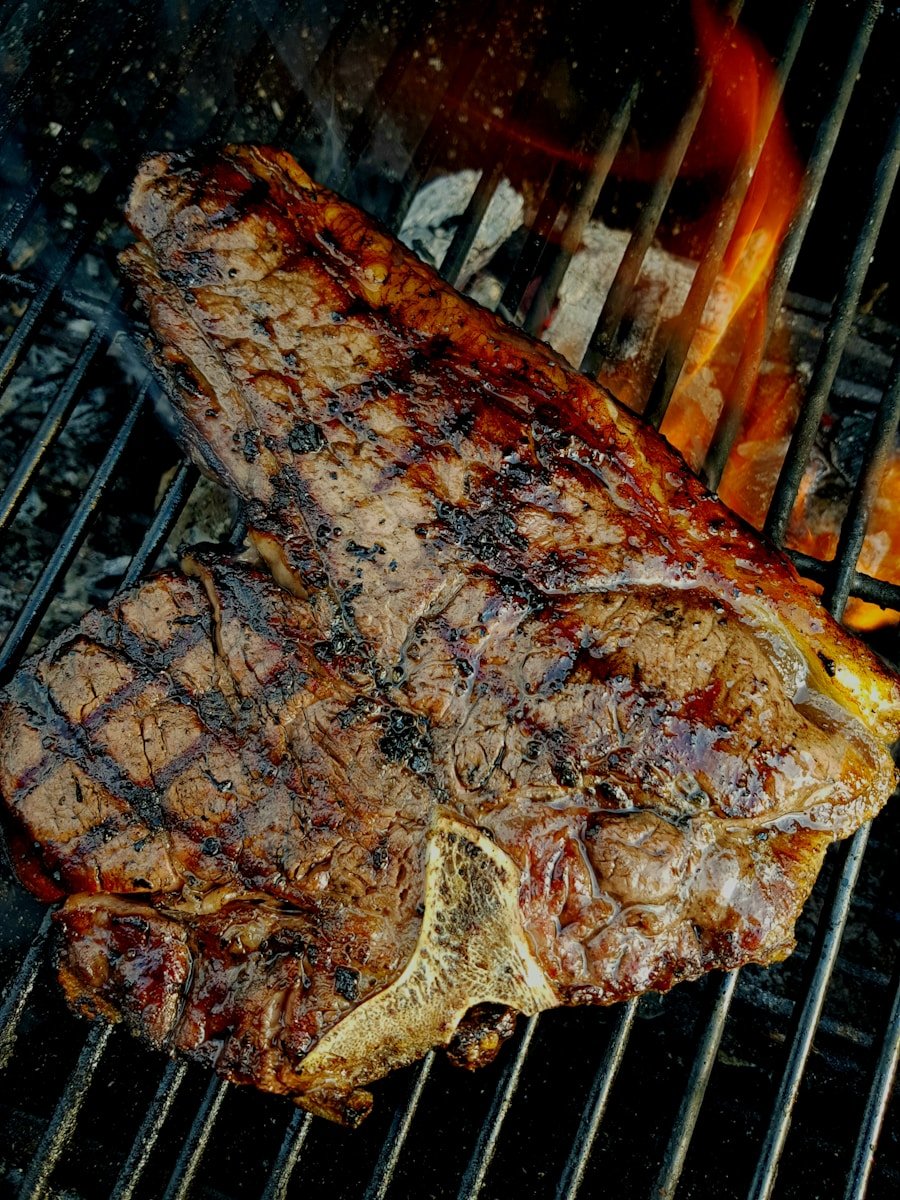Choosing the right cut of meat is fundamental to achieving a delicious grilled steak. The variety of cuts available can be overwhelming, but understanding the characteristics of each can help you make an informed decision. Popular cuts for grilling include ribeye, sirloin, filet mignon, and T-bone.
Ribeye, known for its marbling and rich flavor, is often considered one of the best choices for grilling. The intramuscular fat in ribeye melts during cooking, imparting a juicy tenderness that is hard to beat. On the other hand, filet mignon is prized for its buttery texture and mild flavor, making it a favorite among those who prefer a leaner cut.
Sirloin offers a balance between flavor and tenderness, making it a versatile option for grilling. It is less fatty than ribeye but still provides a satisfying taste. T-bone steaks, which feature both the tenderloin and strip steak, are perfect for those who want to experience two textures in one cut.
When selecting your steak, consider factors such as thickness and marbling. A thicker cut will generally yield a juicier steak, while good marbling indicates a higher fat content that contributes to flavor and tenderness. Additionally, sourcing high-quality meat from reputable butchers or farms can significantly enhance your grilling experience.
Key Takeaways
- Choose the right cut of meat for grilling, such as ribeye, sirloin, or filet mignon, based on your preference for tenderness and flavor.
- Prior to grilling, prepare the steak by allowing it to come to room temperature and patting it dry to ensure a good sear.
- Experiment with seasoning and marinating techniques, such as dry rubs, wet marinades, or simple salt and pepper, to enhance the flavor of the steak.
- Achieve the perfect grill temperature by preheating the grill and using a meat thermometer to ensure accurate cooking.
- Master grilling time and techniques, such as direct or indirect heat, to achieve the desired level of doneness for your steak.
- Allow the steak to rest after grilling to redistribute the juices, then slice against the grain for maximum tenderness.
- Consider serving suggestions and accompaniments, such as compound butter, chimichurri sauce, or grilled vegetables, to complement the steak.
- Troubleshoot common grilling mistakes, such as overcooking, under-seasoning, or flare-ups, to improve your grilling skills.
Preparing the Steak for Grilling
Preparation is key to ensuring that your steak turns out perfectly on the grill. Start by bringing the steak to room temperature before cooking; this typically takes about 30 minutes. Allowing the meat to warm up helps it cook more evenly, reducing the risk of a cold center while achieving a beautifully seared exterior.
While the steak is resting, you can also trim any excess fat if desired, although some fat is beneficial for flavor and moisture during grilling. Once the steak has reached room temperature, pat it dry with paper towels to remove any excess moisture. This step is crucial because moisture on the surface can hinder the development of a good sear.
After drying, you may choose to score the fat cap on cuts like ribeye or T-bone. Scoring involves making shallow cuts in a crosshatch pattern on the fat side, which helps render the fat more effectively during cooking and prevents the steak from curling up on the grill. With these preparations complete, your steak is ready for seasoning and marinating.
Seasoning and Marinating Techniques

Seasoning is an essential aspect of preparing steak for grilling, as it enhances the natural flavors of the meat. A simple yet effective approach is to use kosher salt and freshly cracked black pepper. Generously season both sides of the steak with salt at least 40 minutes before grilling; this allows the salt to penetrate the meat and enhance its flavor.
If you prefer a more complex flavor profile, consider adding garlic powder, onion powder, or smoked paprika to your seasoning mix. Marinating is another technique that can elevate your grilled steak. A marinade typically consists of an acid (like vinegar or citrus juice), oil, and various herbs and spices.
The acid helps tenderize the meat while infusing it with flavor. For example, a marinade made with balsamic vinegar, olive oil, minced garlic, and fresh rosemary can impart a delightful taste to your steak. Allow the meat to marinate for at least 30 minutes or up to several hours in the refrigerator for maximum flavor absorption.
However, be cautious not to marinate too long, especially with acidic marinades, as they can break down the meat’s texture and make it mushy.
Achieving the Perfect Grill Temperature
| Grill Temperature | Meat Type | Doneness |
|---|---|---|
| 225°F – 250°F | Pork ribs | Fall-off-the-bone tender |
| 350°F – 400°F | Chicken breast | Juicy and fully cooked |
| 450°F – 500°F | Steak | Medium rare to medium |
The temperature of your grill plays a crucial role in how well your steak cooks. For optimal results, preheat your grill to high heat—around 450°F to 500°F—before placing your steak on it. This high temperature allows for proper searing, which locks in juices and creates that coveted crust on the outside of the meat.
If you’re using a charcoal grill, ensure that your coals are evenly distributed and glowing red before starting to cook. For gas grills, turn on all burners to achieve an even heat distribution across the cooking surface. Once preheated, you can create two zones: one for direct heat (high temperature) and another for indirect heat (lower temperature).
This setup allows you to sear the steak over direct heat and then move it to indirect heat if it needs more time to reach your desired doneness without burning. Using an instant-read thermometer can help you monitor the internal temperature of the steak accurately, ensuring that you achieve perfect doneness every time.
Grilling Time and Techniques
Grilling times can vary based on the thickness of your steak and your preferred level of doneness. As a general guideline, a one-inch thick steak typically requires about 4-5 minutes per side for medium-rare doneness (130°F to 135°F). For medium (140°F to 145°F), aim for about 5-6 minutes per side.
It’s essential to avoid flipping the steak too frequently; instead, let it sear undisturbed for several minutes before turning it over. This practice allows for better caramelization and flavor development. Another technique to consider is using the “touch test” method to gauge doneness without relying solely on a thermometer.
By gently pressing on the steak with your finger or tongs, you can assess its firmness: a rare steak will feel soft and squishy, while a medium-rare steak will have some resistance but still yield slightly when pressed. A medium steak will feel firmer but still have some give, while well-done steaks will feel very firm with little give at all. This method takes practice but can be a useful skill for any grill master.
Resting and Slicing the Steak

After grilling your steak to perfection, it’s crucial to let it rest before slicing into it. Resting allows the juices within the meat to redistribute throughout, resulting in a more flavorful and juicy final product. A good rule of thumb is to let your steak rest for about 5-10 minutes after removing it from the grill.
Cover it loosely with aluminum foil during this time to keep it warm without steaming it. When it comes time to slice your steak, pay attention to the grain of the meat. The grain refers to the direction in which the muscle fibers run; cutting against the grain shortens these fibers, making each bite more tender and easier to chew.
For example, if you’re slicing a flank steak or skirt steak, you’ll want to cut across the width rather than along its length. Use a sharp knife for clean cuts and aim for slices that are about half an inch thick for optimal presentation and enjoyment.
Serving Suggestions and Accompaniments
The way you serve your grilled steak can elevate the entire dining experience. Consider pairing your steak with complementary sides that enhance its flavors without overpowering them. Classic accompaniments include grilled vegetables such as asparagus or bell peppers, which add color and freshness to your plate.
A simple salad with mixed greens dressed in vinaigrette can provide a refreshing contrast to the richness of the meat. For those looking to add an extra layer of flavor, consider serving your steak with sauces like chimichurri or béarnaise sauce. Chimichurri—a vibrant sauce made from parsley, garlic, vinegar, and olive oil—adds brightness and acidity that pairs beautifully with grilled meats.
Béarnaise sauce offers a rich and creamy texture that complements steaks exceptionally well. Additionally, consider garnishing your dish with fresh herbs or a sprinkle of flaky sea salt just before serving for an elegant touch.
Troubleshooting Common Grilling Mistakes
Even seasoned grillers can encounter challenges when cooking steaks outdoors. One common mistake is overcooking the meat due to high heat or prolonged cooking times. To avoid this pitfall, always use an instant-read thermometer to check internal temperatures rather than relying solely on visual cues or timing alone.
If you find yourself with an overcooked steak, consider slicing it thinly against the grain and serving it in tacos or salads where additional flavors can help mask dryness. Another frequent issue is flare-ups caused by excess fat dripping onto hot coals or burners. To manage flare-ups effectively, keep a spray bottle filled with water nearby; if flames rise unexpectedly, a quick spritz can help control them without dousing your fire entirely.
Additionally, if you notice excessive flare-ups while grilling fatty cuts like ribeye or pork belly, consider moving them to indirect heat until they finish cooking through without burning. By understanding these common pitfalls and employing effective techniques throughout each stage of grilling—from selecting quality cuts of meat to mastering cooking times—you can elevate your grilling game significantly and enjoy perfectly cooked steaks every time you fire up the grill.
If you’re looking to up your grilling game beyond just steak, you might want to check out this article on the 5 Best Tortilla Presses for Homemade Tortillas. Making your own tortillas can take your BBQ spread to the next level. And while you’re at it, you might also want to consider investing in one of the 5 Most Effective Stainless Steel Cleaners to keep your grill looking shiny and new. And to keep your eggs fresh for those breakfast burritos, check out the 5 Top Smart Egg Trays with Freshness Tracker. Happy grilling!
FAQs
What is medium rare steak?
Medium rare steak refers to a steak that is cooked to an internal temperature of 130-135°F (54-57°C). It is characterized by a warm red center and a slightly charred exterior.
How do I grill steak to medium rare?
To grill steak to medium rare, preheat your grill to high heat. Season the steak with salt and pepper, then place it on the grill. Cook for 4-5 minutes on each side, or until the internal temperature reaches 130-135°F (54-57°C).
What type of steak is best for grilling to medium rare?
Steaks such as ribeye, striploin, and tenderloin are best for grilling to medium rare. These cuts are tender and flavorful, and they cook quickly on the grill.
Should I let the steak rest after grilling?
Yes, it is important to let the steak rest for 5-10 minutes after grilling. This allows the juices to redistribute, resulting in a juicier and more flavorful steak.
How can I tell if the steak is medium rare without a meat thermometer?
You can use the touch test to determine the doneness of the steak. A medium rare steak will feel slightly springy and offer some resistance when pressed with your finger. It will also have a warm red center when cut.

